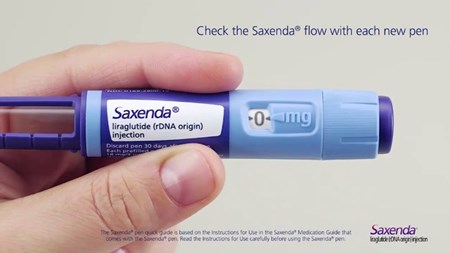Saxenda Weight Loss Injections
 Saxenda weight loss injections, also known as ‘the skinny pen’ burst onto the U.K market back in 2017, with exciting results for people who need help with weight loss.
Saxenda weight loss injections, also known as ‘the skinny pen’ burst onto the U.K market back in 2017, with exciting results for people who need help with weight loss.
In one study of 3,731 people, 3 out of 5 achieved significant weight loss of 5% or more, and 1 in 3 achieved weight loss of 10% or more (1).
But how much does the weight loss pen, Saxenda weight loss injections, cost in the U.K? and is it worth it?
The truth is… it depends where you are in your weight loss journey right now.
If you need to lose a little weight and you’ve read about ‘the skinny pen’ then you may have been sucked into hype and need to be very, very careful. Saxenda weight loss injections are unlikely the best option for you if your Body Mass Index (BMI) is less than 27. Speak to your doctor.
If your BMI is over 27 and you have a weight related medical condition OR you’re living with obesity (have a BMI over 30) and have tried and failed at calorie controlled diets before… then this weight loss supporting injection may be the right next step for you (2).
How Saxenda works (and why we only recommend it if hunger is holding back your weight loss dreams).
Saxenda is the brand name for the active ingredient, Liraglutide. Liraglutide is an appetite suppressant that mimics the hormones in your brain that regulate hunger (3).
There is no guarantee that reducing hunger will delete extra weight, but reducing hunger pangs should help avoid the urge to overeat and to snacking in between meals.
Saxenda weight loss injections arn’t a miracle cure (though we wish it was).
It’s a tool which should be used alongside a calorie deficit diet and a doctor approved exercise program. This is why we’ll send you an access code to the Liva Healthcare app when you buy from us, so you can track and monitor your health and lifestyle goals.
You’ll also have access to a Liva health coach to ask questions within the app.
How much does Saxenda cost in the U.K?
To get the best results from Saxenda, you need to slowly increase your dose until you reach 3mg per day.
It’s easy to change the dose, you can see a simple dial mechanism at the top of the pen.

This means when you start, your pen will last much longer, because you are using less each time you inject than you will be when you are up to the full dose.
Here at our family owned pharmacy, we keep our prices as low as possible, and we help you with discounts to enable you to successfully continue on your weight loss journey..
So let’s look at a typical example.
The recommended dosage for Saxenda when you start is 0.6mg once a day, which increases by 0.6mg each week (2).
A typical dosing schedule works like this:
- Week 1: 0.6mg once daily for 7 days
- Week 2: 1.2mg once daily for 7 days
- Week 3: 1.8mg once daily for 7 days
- Week 4: 2.4mg once daily for 7 days
- Week 5: 3.0mg once daily ← this is the full dose and you will stay at this dose for as long as you need to.
How does the dosage schedule affect the cost?
When you’re starting out, a single pen will last you 17 days.
If you buy a pack of 5 then they’ll last you 44 days…
...so a 5 pack will take you through to week 6.
Once you are at the optimum dosage (3mg/day), the 5 pen pack should last you 30 days.
In terms of investment… it depends how many pens you buy at a time. One pen works out at £75, but if you buy the 5 pen multipack, this is reduced to £60/pen (2).
How long do I need to take this for?
You’ll know pretty soon if this solution is working for you.
You should lose 5% of your starting body weight by week 12. If you have not achieved this using Saxenda, then you should stop the regime (always talk to your doctor or qualified pharmacist first). (2)
In terms of when you’ll stop, it depends on you and your progress. Some people stop when they hit their target weight, and some people continue to help them maintain their weight loss (1).
Here at Webmed Pharmacy, our lead pharmacist Margaret, is available during office hours to chat about your progress and answer any questions you have.
In fact, the manufacturer of Saxenda, Novo Nordisk, said this about us:
“Webmed's service is so supportive and ethical, it definitely stands out from the others”
Check out more about Saxenda
1. Benefits of Saxenda [cited 12/08/21] Available at: https://www.saxenda.com/about-saxenda/benefits-of-saxenda.html
2. Saxenda [cited 12/08/21] Available at: https://webmedpharmacy.co.uk/buy/saxenda
3. How Saxenda Works [cited 12/08/21] Available at: https://www.saxenda.com/about-saxenda/how-it-works.html
Author: Gemma Boak
Medically reviewed by: Superintendent pharmacist Margaret Hudson BSc(Hons)MRPharmS 04/10/21